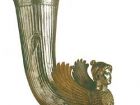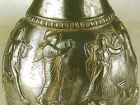THE BOROVO TREASURE - A FEAST EATING OR A SACRIFICIAL SET
THE BOROVO TREASURE
A FEAST EATING OR A SACRIFICIAL SET
A FEAST EATING OR A SACRIFICIAL SET
In 1974 peasants performed deep plowing off the village of Borovo, Russe region. Unexpectedly, two kilometers west of the village, in a place called Belenski mound and 200 m off a large ancient burial mound, they uncovered a set of silver vessels. The machines damaged badly the vessels but after the expert work of restorers on them specialists came to the conclusion that the find consists of three rhytons, a broad shallow vessel (a plate) and a small decanter. They were all taken to the Russe Historical Museum. The first version was that it was part of an eating set.
It must be noted that on inspecting the site of the discovery they didn't find any traces of a burial. Therefore the treasure must have been hidden in the ground under unknown circumstances.
The manner of production and the type of ornamentation of the vessels are of great interest. The first of the rhytons is decorated with a beautiful torso (front part) of a horse. It is made in a plastic and realistic way, which can be seen in the individual details (the eyes, the nostrils, the mane). Under the abdomen of the horse there is an inscription in classical Greek, which reads: "From Cotis to Beo."
The second rhyton is not less interesting. It is decorated with the image of a winged sphinx, an exact replica of the sphinx on the first one. It is again surrounded by decorative elements: ovals, pearls, ivy leaves and a bird perched on them. An inscription cut with small dots onto the surface again repeats the one on the first rhyton.
The third rhyton is decorated with the figure of a bull and differs from the first two. It has similar decorative row of details, mostly animal figures, which leads us to a Persian artistic influence. This has contributed to the mixture of realistic stylistic details with purely realistic ones.
Very interesting is the shallow plate put on a cone-like stand. It has two massive handles to which are welded the heads of satyrs (mythical forest creatures from the suite of god Dionysus). They have beards, mustaches and curly hair. Their mouths are open, the nose is broad, and they have animal ears. The bottom of the vessels contains a scene with convex form - a doe attacked by a griffin with a bird's head. This is a motif well known from other Thracian monuments. The modeling is very familiar and expresses perfectly the dynamics of the movement of the two animals.
The last vessel is an amphora-like decanter (now lost) with a handle. On it, in a number of circles, are presented different scenes. In the one we have three flying swans with elegant necks, facing each other. The next circle is full of scenes from the Dionysus cult. Of exceptional artistic perfection are two central figures of a man and a woman holding a snake in her hands. The man has long hair and long beard, on his head there is an ivy wreath out of which shows another snake. This is undoubtedly Dionysus. It is interesting that next to him we see a second man lying on a lion's skin and this is no doubt Heracles, after his fight with the lion. This mythical half-god half-man is holding in his hands rhytons similar to those on the other three vessels in the treasure (decorated with a griffin and a sphinx).
The question is whether the vessels from the treasure have a domestic function — let's say for eating, or their ornaments speak of a ritual function. The detailed analysis leads to the conclusion that the second presumption is more plausible without being able to determine the exact ritual. There is no doubt that it is related to Dionysus though. In Greek mythology he was the god of fecundity, the protector of vegetation and of vine-growing in particular.
The inscriptions on the vessels mention the name of the Thracian ruler Cotis (383-360 BC) and the name of the silversmith who made the vessels probably on his order. May be Cotis used to present such valuable vessels to his local nobles one of whom was from the Geti tribe.
The treasure is a high achievement of jewelry making. It is produced from a silver sheet, molded and then stamped with figures and graphic decorations. The scenes and the technique show that this must have happened in the first half of the 4th c. BC. It was buried in the ground during some of the marches of the Macedonian kings Philip and Alexander the Great against the Thracians.
It is interesting to mention the opinion of some archeologists that this happened after some of the disastrous earthquakes during the 3rd c. to calm the elements of nature.
This has not been proved but we must note that the Borovo Treasure is an invaluable monument of the Thracian period, which combines various cultural trends — local Thracian, Hellenic, and Persian.







